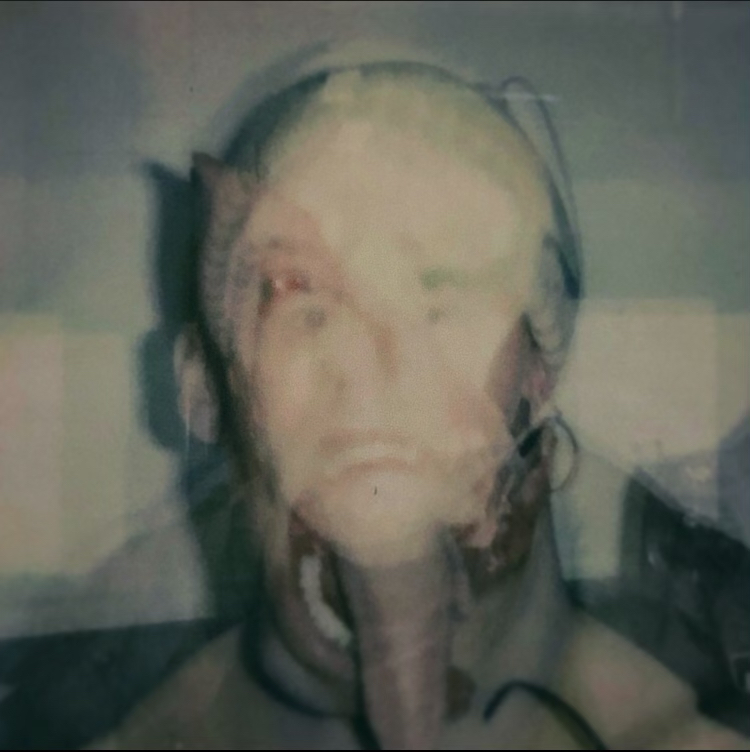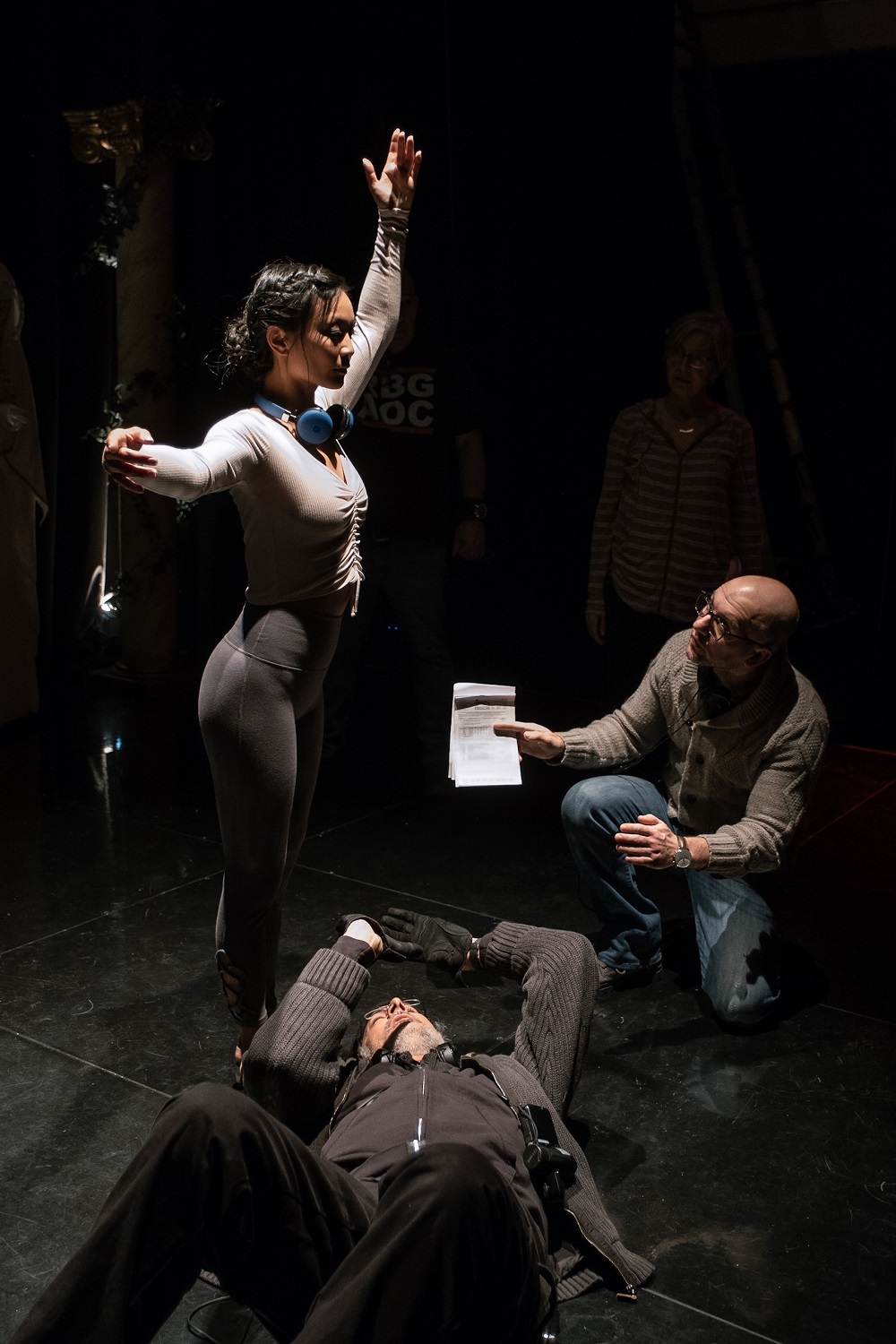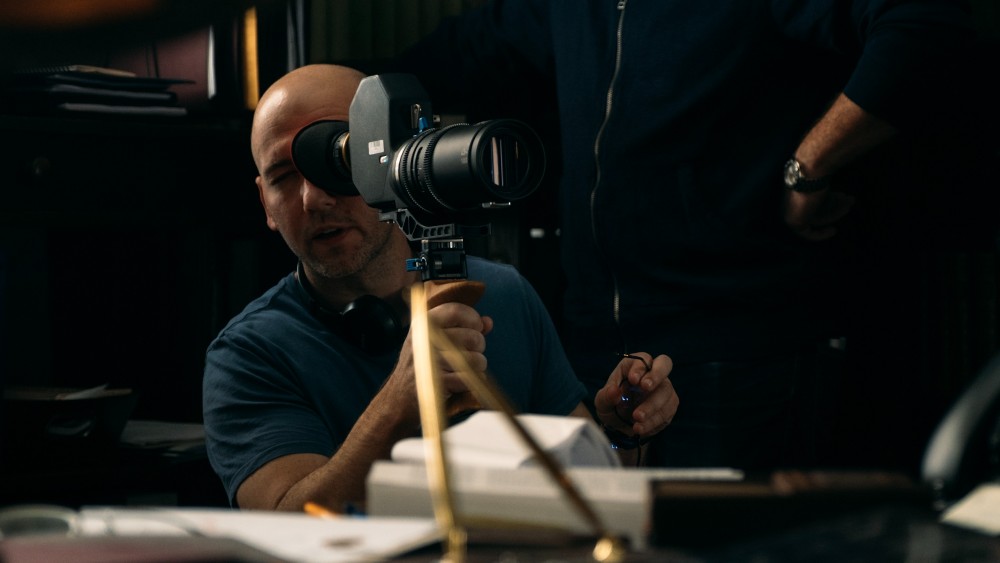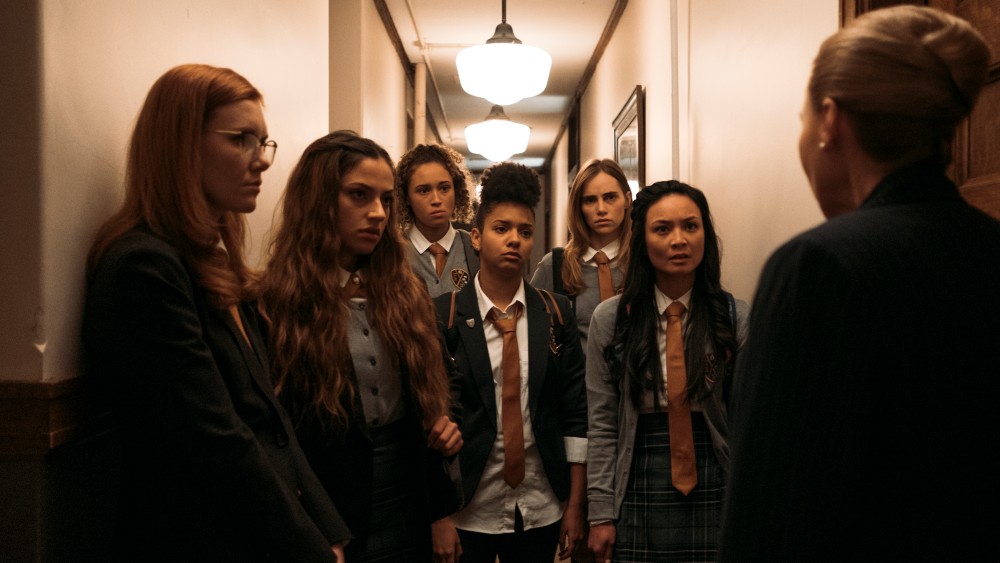![[L-R] Stephanie Sy as Yvonne, Inanna Sarkis as Alice, Madisen Beaty as Bethany, Djouliet Amara as Rosalind, Suki Waterhouse as Camille, and Ella-Rae Smith as Helina in Seance](https://www.btlnews.com/wp-content/uploads/2021/05/Seance_PR-STILL_6.jpg)
From his early days making horror films with Adam Wingard, this creative duo became a recipe for success, beginning with the ultra-low budgeted V/H/S/2 and A Horrible Way To Die. This paved the way for their next projects, You’re Next and The Guest, which drew attention from fans and developed a cult following that continues to this day. The success of The Guest, in particular, opened up doors that led to the much-anticipated Blair Witch in 2016. With Seance, Barrett takes on the role of both director and screenwriter, which is not without its challenges.
Below The Line got on the phone with Barrett last week to talk about his directorial debut, the challenges he faced getting to this point, and a fair amount about Scream 2.
Below The Line: Congratulations on your directorial debut. What was the deciding factor or factors that led to this? This transition to directing?
Simon Barrett: I’ve been trying to direct a feature film for over 20 years, and when I started, it didn’t really work out for me. I became a screenwriter, because the first low-budget horror script I wrote to direct myself. By accident, I ended up selling to a studio through a friend who I wanted to cast. [It] got to some of the right people, and ended up going a different route. I was incredibly fortunate, but it wasn’t the route that I intended for myself, but I wasn’t going to be a fool and not take full advantage of it. At the time, the studio who wanted to make that film wouldn’t take a chance on me directing it, of course, so I ended up kind of being a horror screenwriter. And that truly was that.
I didn’t have a body of work as a director, but I did as a writer for a little while, and then, when I started working with Adam Wingard, that started to be a lot more fulfilling for me because I was producing those films very directly and heavily involved in them, at least when they were very low budget. When the budgets started getting bigger, as we got more successful, that’s when I started thinking, “Okay, I need to come up with a project for myself to direct again.”

BTL: It sounds like you just built up the reputation over the years, and then when it came time for you mentally to do something, when all the cogs fell into place, you just took it. Is that what I’m hearing?
Barrett: Somewhat. Seance took me five years to put the financing together. Even though people in the industry knew that I had been involved in films like You’re Next and The Guest, I don’t think they really knew what my level of direct involvement was in those processes, and whether I could really direct a feature without Adam there. But HanWay Films, who’d financed You’re Next and The Guest, stepped in to be the initial financier for Seance, and that was the vote of confidence that I was eventually able to use to bring on Ingenious Media and Dark Castle Entertainment in the US and get the financing. In terms of my own talent and ability, I guess that kind of remains to be determined how I did. But I felt that the point that I made Seance, I had enough experience on some sets of that budget level, that I was feeling a bit more confident than if I’d done it even five years earlier.
BTL: Speaking of the story of Seance, what inspired the film, and did any of your previous experiences as a private investigator come to influence how things unfold?
Barrett: I think I’m influenced by things very directly, both the art that I consume and real-life inspirations. My brain doesn’t tend to work in a direct way where I see an entertaining thing or experience or I have an interesting life experience, and then I choose to tell that story. I tend to actually think that my life itself is probably pretty boring to anyone other than myself, and I think more screenwriters should maybe consider that that might be the case.
What I would say is, however, certainly doing that work, and kind of compartmentalizing my life where a lot of my friends weren’t really aware that I was doing that kind of work. Because I was trying to pretend that I was a successful filmmaker and that I didn’t really have this kind of complicated, difficult to explain day job, and so I think like the element of having a private life or like a private profession, and the anxiety of just human dishonesty and being able to relate to other humans on a certain level. I think Seance is very much kind of about that and I think You’re Next and The Guest kind of are too, and that they’re kind of all films about characters that have secrets and are hiding things from one another.
Seance is a movie that I think is much more optimistic about the possibility of human connection despite all these difficulties than You’re Next or The Guest maybe. But all films have a sense of lightness and humor to them that I think ultimately is anything I want to say is. I do have some positive messages in there, but yes, I think working as a P.I. kind of affected the themes of the film, but probably not its direct narrative, which was much more influenced by just other fiction, right?

I would say ironically, I fell into P.I. work through absolutely no interest. It literally was just a job available to me at a time when I needed a job, and the hours were flexible, and so I took it for that reason. I think most people can relate to this. And so, I initially was pretty excited about the job because I had spent my entire life reading detective fiction, ranging from more kinds of classical works to just very kind of sleazy pulp yarns. I’ve kind of devoured all, especially as a kid. I read every Nancy Drew book, but I didn’t like the Hardy Boys books as much, but I read them anyway. I read everything by Agatha Christie. There were just certain authors, I would just discover them, and I would read 50 books by them, Jim Thompson being another one. So that really was what shaped my personality, probably almost more than any other body of fiction, is those old detective books.
It’s kind of unclear, did I become a P.I. in some weird way because I spent so much time reading P.I. fiction, and then that kind of led to Seance? Or is it all just this weird continuation of my obsession with single location, detective stories, and with a weird interlude of being an actual licensed P.I. somewhere in between? I don’t know. It’s very weird that I worked as a P.I., to be honest, and nothing I did is very interesting.
BTL: Things just happen. It’s just one of those things where…I don’t know.
Barrett: That’s exactly right. [laughs] That’s exactly right. It’s true.
BTL: I’ll be honest. This whole thing that I’m doing right now? Never planned on it. It just happened.
Barrett: I think a lot of people feel that way. A lot of people are just interested in the arts and so on, and you just kind of find out like, “I’m pretty good at this,” and then you just end up doing it for a while. Maybe it becomes a real passion, and you find a way to turn it into something brilliant. Or, you pivot. It’s one of those weird things. That’s life. I’m very lucky to now be doing what I’ve always wanted to do. But we’ll see how that goes. We’ll see how long I can do it for.
BTL: Speaking of passion, am I crazy for thinking that there are horror Easter Eggs in this film? Or am I just reading too much into it? Because there were moments where I was like, Scream 2? And then, in the beginning, with the scene in the bathroom, I was like, “Is this a wink-wink, nudge situation?”
Barrett: I think, especially with The Guest, people started watching, that was the first movie where I felt like viewers understood that Adam and I were definitely referencing other films in that piece of work. But again, it wasn’t ever I think too direct or obvious. We weren’t ever doing a stylistic homage to those movies. We shot it in the style that Adam wanted to shoot it. But we didn’t try to make it look like Halloween III, but we wanted to kind of feel in certain ways like Halloween III or Terminator II or Face/Off, and the films that we kind of put little hints about in The Guest.

I would say Seance is the same. The opening of the film is trying to reference the actual Bloody Mary urban legend that I’d always wanted. That opening scene was one that I’d always wanted to do. I always tried that in a couple of different scripts, actually. I always tried that in a couple of different scripts, actually. It never quite worked, but I always was trying to find a variation of that opening scene and, ultimately, I was able to find a room for it in Seance. And I think it’s just because one of my biggest cinematic obsessions, both as an adult and in my youth, was Candyman. But the actual Bloody Mary incantation can really only be found, I think, in like cinema such as Urban Legends: Bloody Mary, which I wasn’t specifically referencing Urban Legends 3, but I have seen it. I’ve definitely seen Scream 2 a few times. I didn’t specifically put in anything there, but I may have unconsciously done something very similar.
BTL: I went back and forth on it, because I don’t look for Easter eggs. I don’t like reading into anything. But it was that moment of this seems familiar. Am I remembering this right? And so, I just needed you to tell me that I was crazy. (Note: Spoiler warning in next response if you haven’t seen Scream 2.)
Barrett: No, I maybe need to rewatch Scream 2. Because certainly the killer motivations in Scream 2, I remember being frustrating to me at the time, because it’s just like, “Oh, it’s this character and this other character, who happened to be played by recognizable actors,” so you kind of probably figured that out because they were only in like two scenes. Otherwise, I remember being a little frustrated by the reveal of Scream 2. That’s my main recollection is that it’s the sister from Roseanne and Timothy Olyphant, right? I wasn’t satisfied with that result, personally. And they shouldn’t have killed Randy. Big mistake.
BTL: Well, clearly, that was.
Barrett: Yeah, they’ve been struggling with that ever since. Alright. [laughs] We agree.
BTL: To wrap things up, I want to discuss the school because that’s such a huge component of the setting, where everything takes place, etc. Did you guys find the location? Did you build it? How did you go about finding that school?
Barrett: The locations of Seance and the look of Seance, first of all, I obviously have to give credit to Director of Photography Karim Hussain and Production Designer Mars Feehery for really doing incredible work with very limited resources. My whole idea in writing it and knowing that this is going to be a fairly small budget film, and my first feature was to do this as kind of a single location shoot. And I wanted to shoot in Winnipeg because I knew there was a lot of old, interesting architecture there, and that did not work out. There were no schools that looked right that were willing to let us film there because of the subject matter of the film, for various reasons. And so, that hadn’t even occurred to me because total filmmaker tunnel vision arrogance. I was just like, why wouldn’t everyone want me to film my wonderful movie there?
So that went badly, and what happened was we ended up cobbling together the location from a bunch of different locations. because we couldn’t afford to build very much. It’s really just the dorm room interiors, and the bathroom interior is built in a storage facility designed to match the hallway of an old bank building, which is what we use for our dorm hallway. The libraries are in the Manitoba Legislative Center. The exteriors are two different buildings, most of which is a private house that we found just by driving around and looking for houses. The study lounge is in the bank building. The principal’s office is in a University Center for retired women to play mahjong at.

Basically, I was just finding buildings in Winnipeg that had vacancies that kind of resembled each other enough that I could put together this visual impression of the school that I had in my mind, and that really was a thing where I’m so glad I had the experience of making films. Specifically, it’s probably not the two films that people would think, but V/H/S/2 and A Horrible Way To Die were such low budget projects that a lot of what people think is one location in those films are just bits and pieces of a bunch of different locations that we only have like an hour to shoot in. That kind of producing experience really helped me with Seance because I think if I hadn’t done that before, I would have freaked out completely being basically like, this is a single location movie. We have 22 shooting days and now we have eight locations meaning like, we’re constantly going to have to be moving. I think I would have shut down, but I was actually like, Okay, I see how we can make this work. I see how we’re going to do this. This will work. I just can only film certain things at certain angles, and that’s just going be the limitation. And it was.
So I’m really gratified whenever people talk about the school in Seance, because there’s truly at no point in Seance do I film a school. Or the closest I get, like I said, is there’s a center for retired women, I think former University of Winnipeg students. They play mahjong and bridge there from like two to four every day. Gosh, what a beautiful building. I’m so grateful they let us film in one of their rooms. That was it. We filmed in one of the rooms in the hallway, and then nothing else in that building worked at all. So, then we moved to a different building.
BTL: That’s really cool that you guys mishmashed all that together to create the school.
Barrett: Yeah, that was the biggest challenge probably of making this movie.
Seance can be seen in theaters, on Demand, and on Digital, starting Friday, May 21.
Photos courtesy RLJEfilms and Shudder except where otherwise noted.





